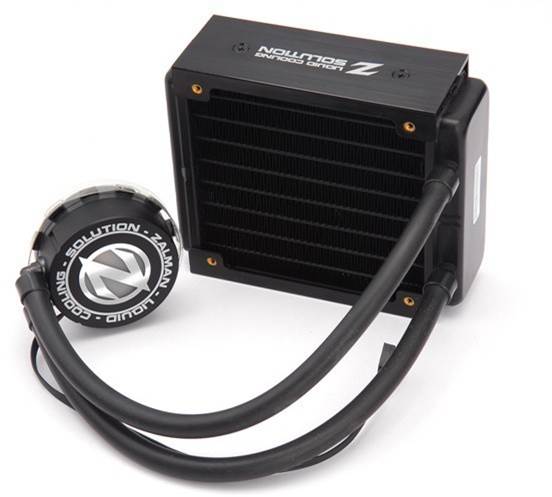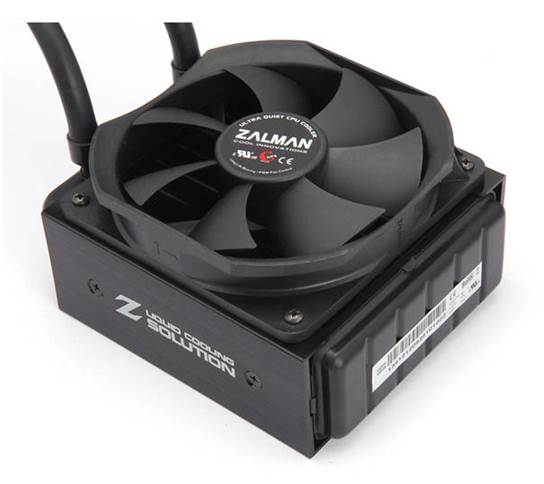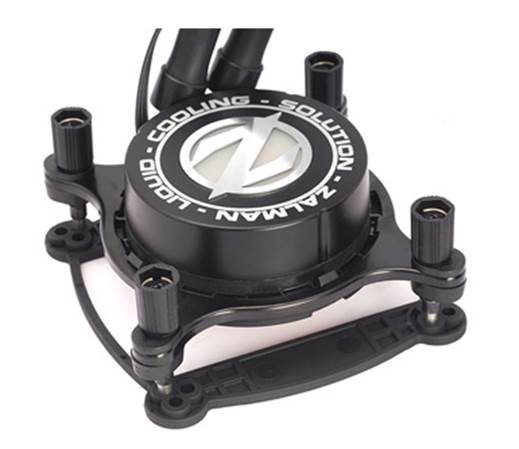Respectable performance, but not for
the price
Zalman has a well-earned reputation for
high-quality air coolers. The "flower" design of its older all-copper
heatsinks was eye-catching and distinctive, and its large (for the time] fans
ran quietly even under load. Lately, though, liquid cooling has been all the
rage. Closed-loop units from companies such as Corsair and NZXT are packaged
with the cooling tubes and pump pre-attached to a radiator referred to as an
"all-in-one" (AiO) design. These units are much less expensive than
cobbling together separate components, and there’s little maintenance required.
The LQ-320 marks one of Zalman’s first forays into the AiO market, and it’s a
respectable part, though arguably priced too high for its performance.

The
LQ-320's radiator gives it 7.7cm of total length, once the fan is installed.
Its noise level isn’t a problem, though.
Left to its own devices, the LQ-320 hovered around 1,700rpm under load,
creating a noise level that was noticeable but not distracting. Even with the
fan cranked to 2,000rpm, it wasn’t that distracting and our overclocked Core
i7-3960X test machine never cracked 70 C under a pretty hefty load. We use an
internal Intel tool to load up the CPU to its limit, more so than with Prime95.
Under normal operating conditions, the
LQ-320 noise level blends into the background pretty much on par with a
Phanteks or Noctua air cooler.
The radiator is large and in charge. At
about 2 inches thick (that's thicker than two stacked case fans), to which you
must bolt a 1-inch-thick fan. If you're sporting an LGA2011 board with tall
RAM, there's a chance the DIM Ms will bump into the cooler but it depends on
your case and motherboard. Unlike a typical fan, the included unit has only
four mounts on one side so it can only be mounted to the radiator where air is
pushed through it.

The
radiator is large and in charge. At about 2 inches thick (that's thicker than
two stacked case fans), to which you must bolt a 1-inch-thick fan
The fan uses a 4-pin PWM plug that goes
directly into your motherboard as opposed to the USB-controlled (and similarly
priced) Corsair H80i or NZXT Kraken X40 "intelligent” coolers. If your
mobo has really granular and intelligent control over fan headers, such as Asus
Fan Xpert 2, it’s probably OK. But if you're using a budget board that’s
“dumb," don't expect much control.
The pump is powered by a separate 3-pin
plug that goes directly into an available mobo fan header. On boards that give
you very little or no control over the fan headers, we'd advise you to get a
$3.50 Molex-to-3-pin adapter to give the pump as much power as possible. Even
on boards with control, we’d recommend that you make sure the pump is getting
the proper voltage to get the full performance out of this cooler.

It
doesn’t really need software tweaking, and you don’t have to factor in software
glitches
But although it lacks control software and
unified cabling, it doesn’t really need software tweaking, and you don’t have
to factor in software glitches. And plugging it directly into your power supply
is not a major inconvenience. The biggest problem with the LQ-320 is actually
its street price of about $90, which is virtually the same as the superior NZXT
X40 and Corsair H80i. Granted, the X40 requires a 14cm fan mount, so it’s not
directly comparable. But since you can buy it for under $100, it's a factor,
and the LQ-320 does not emerge victorious. If the LQ-320 settled into the
$60-$70 range, it would probably fare better.
Zalman LQ-320 CPU Cooler
Pros
·
High-quality construction
·
Performs better than almost all air coolers
Cons
·
Price is not in line with the competition;
·
Lacks software controls.
·
Price: $110
·
Website: www.zalman.com
Specifications
·
Dimensions (HxDxW) 2 x 6 x 4.8 inches
·
Weight 1.9 lbs
·
Socket support 1x 12cm PWM
LGA1155/1156/1366/2011; AM 2/ AM2+/AM3/AM3+/FM1
·
Additional Fan Support One 12cm (screws
included)
|